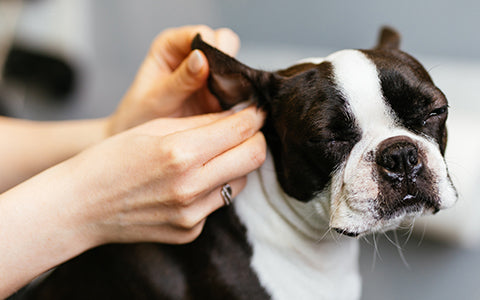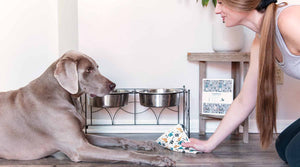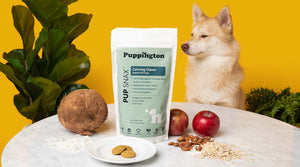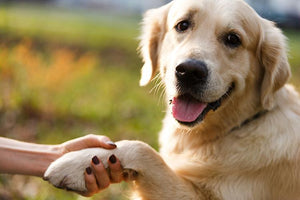Your Cart is Empty
FREE SHIPPING SITEWIDE!! | TAKE THE QUIZ & SAVE 15%
FREE SHIPPING SITEWIDE!! | TAKE THE QUIZ & SAVE 15%
FREE SHIPPING SITEWIDE!! | TAKE THE QUIZ & SAVE 15%
October 24, 2022 8 min read
By now, taking your pup to the groomer may not be an option, or you may still feel safer choosing to keep your pup home. It may be easier and cheaper for you to take care of your dog's basic grooming needs in the comfort and familiar environment of your home. A lot of things have changed since 2020: we don’t see people as much, we definitely don’t high-five anyone, and now, we’re expected to know how to be a professional dog groomer!
If your dog’s fur has grown so long that it looks like they’re wearing an old wig and their coat is starting to resemble an old, worn coat (that was dragged through the dirt and left out in the yard), it’s time to brush up on dog grooming skills - and brush your pup's teeth, too!
Letting too much time pass in between grooming sessions can put your pup's health at risk.
Luckily, you can perform many grooming tasks safely in the comfort of your home. You don't need sophisticated, expensive equipment for easy tasks like trimming nails or brushing hair. Thank goodness, because who has room for more things when you've got stockpiles of toilet paper, flour, and cleaning supplies spilling out of your closets?!
We like the home grooming kits at DIY Groomer. Pup tip: save 10% off your first order there with code PUPWAX10. Puppington also has its own 2-in-1 Deshedding and Grooming Dog Brush to help you with your pup's coat needs.
We've broken home grooming down for you in 10 easy steps:
8. Cleaning and Protecting Your Dog's Paws
9. Bathing, Drying, and Styling Your Dog's Coat
1. Eyes
Use a soft damp cloth to wipe around your dog’s eyes. Dirt and crust (from tears) tend to collect here, and too much build-up can lead to an infection. While you’re at it, check the eyes for any signs of reddening or swelling.
Your pup’s eyes need to remain moist. Dry eyes can affect your dog’s ability to see or lead to irritation. Make sure the room your dog is in is humid enough or use eye drops if needed.
Pup tip: artificial tear drops can be used to moisten your pup’s eyes. Consult with your vet first before administering eye drops.
2. Ears

Dirt and wax collect in your dog’s ears too. With a clean damp cloth, wipe the folds and flaps of the ears. Alternatively, you can use cotton balls and gauze to clean the ears.
Pup tip: never use Q-Tips (human-style cotton swabs) to clean your dog’s ears at home. They can damage their eardrums.
Clean your pup’s ears every four weeks. If your dog produces a lot of wax or frequently gets their ears wet while swimming, then clean the ears as often as every two weeks.
3. Nose
The nose of a healthy dog is moist most of the time. If your dog’s nose feels dry, It could be due to dry air, dehydration, sunburn, or other reasons. It's normal for a dog's nose to become a little dry at different points throughout the day, for instance during a long nap. Provide your dog with plenty of water and ensure the room they are in is humid enough. Applying a high-quality balm such as Pup Wax will help to keep your dog's nose moist. If you're not sure whether you should be worried about your dog's dry nose, check out our mini-guide all about caring for your dog's nose.
4. Next, Brush Your Dog’s Teeth
Dogs develop bad breath if their teeth are not cleaned regularly. Plaque and tartar also build up on your pup’s teeth without frequent care. Did you ever notice your dog wants to cuddle seemingly on the days they have the most unique breath? Let’s fix that!
Brush your dog's teeth a couple of times a week. Do not use human toothpaste on your dog's teeth. A little research online will also lead you to the best canine toothpaste brands, or your vet can recommend one that will work well for your pup.
Pup tip: chew toys and high quality canine dental chews will do much of the teeth cleaning for you.
Letting your dog chew on antlers or certain types of bone will also help clean their teeth. Confirm with your vet what kinds of bones are appropriate for your dog based on their size, dietary restrictions, and teeth.
5. Brush Your Dog’s Coat
As quarantine keeps us locked in, your furry friend is bound to get, well, really furry. It is up to you to trim and brush your pup’s coat to ensure they always look and feel their best. Turns out “their best” isn’t after 3 months of fur growth that makes them look like if a pile of barbershop hair had legs!
In all seriousness, matted hair should always be addressed immediately if you notice it. Matting reduces air circulation and can lead to severe medical problems for pups of all ages, from skin irritation and infected lesions to insufficient blood supply and strangulating wounds.
Brushing your dog's coat daily helps remove dirt & dead hair, get rid of tangles, keep the coat smooth & shiny, and prevent matting. If your pup has long hair, a metal brush comb is perfect to keep those strands smooth and lush. A grooming mitt or glove brush is perfect for short-haired dogs.
Brush your dog’s hair a couple of times a week to keep it neat. If your dog has curly hair that is more prone to tangling and matting, brushing their coat daily will help keep it smooth and detangled.
6. Trim Your Dog’s Coat
Trimming your dog’s coat requires a keen eye and extra patience. Keep the trimming session fun with a lot of extra treats and have the following simple tools handy:
A rule of thumb when cutting your dog's hair is to start from the neck and move down to the tail. For short-haired dogs, a pair of curved or straight scissors is all you need to trim the coat. For long-haired dogs, you can start with the clippers then finish off with scissors.

Pup tip: Let your dog stand or sit on an elevated table before the barber session. This gives you better access to their coat.
Trim your pup’s coat in the direction their hair flows. Going against the normal flow of hair creates lines on their coat. Hair clippers come with different guards to cut hair at different lengths. Always start with the largest clipping guard and move to the smallest.
Ensure the clipper is placed flat on the coat while shaving. This prevents you from shaving too deep or cutting your dog’s skin.
After the neck, move to the back and abdomen. Be very careful about sensitive areas like the underbelly, underarm, and hock. If shaving these areas with a clipper irritates your dog, switch to a pair of scissors. Always hold the point of the scissors facing away from your pup and trim away with the scissors.
Lastly, trim the head, legs, and tail. These should be the last areas to shave as you might anticipate the most movement. If possible, have someone hold your dog while you carefully trim them.
Hold your dog's head very still while grooming their face. Brush their face to expose long strands and trim away with the scissors. Be gentle with clippers as you slowly follow your dog’s facial lines. If you opt to use only scissors, thinning scissors might be preferable as they don't leave straight scissoring cut lines behind, so the result tends to be more natural.
Trim the ear flaps, the sides of the face, and below the jaws. Do not forget to trim the eyebrows, especially for dogs that grow a lot of facial hair.
Trim one leg first, and then move to the next. With a pair of scissors, trim between the paw pads to remove excess hair. Paw pad hair tends to harbor a lot of germs.

Brush the tail first before trimming with a clipper or scissors. Hold the tail steady and gently trim away to the tip.
Pup Tip: Always have treats to keep your dog busy while shaving them.
How To Keep Your Dog’s Nails And Paws Clean
Overgrown nails can cause walking difficulties in dogs. Also, long paw nails easily break or curve inwards and even pierce the paw pads. Not only do they potentially hurt, you probably don’t want your pup’s nails looking like they’ve spent the last two days trying to dig a tunnel to the other side of the world.
Many pups grow to be very sensitive to having their paws or nails handled. If you have a young puppy, start trimming their nails at home from a young age to get them used to the process. Frequent treats are your best friend during pawdicures!
7. Cut Your Dog's Nails
8. Clean, Moisturize, & Protect Your Dog's Paws


9. Bathe, Dry, & Style (Your Dog’s!) Fur Coat
Most dogs only need to be bathed once or twice a month. But for dogs that shed a lot, bathing them once a week will help remove dead hair and pet dander.

Use a clean towel to dry the coat after a soothing shower with a spray nozzle. If your pup is long-haired, a blow dryer will effectively dry the coat.
10. Pup Massage
A certified groomer knows all the main muscle groups and acupressure points in your dog. If you are willing to learn how to give your dog some TLC through a soothing pet massage, check out our comprehensive post on effective dog massage techniques.

Which Services Should You Leave To A Groomer?
As you can see, it is not that hard maintaining your pup's good looks while at home - but there are some tasks you should leave for your vet or professional groomer. Such services include assessing your dog for any skin diseases and parasites. A vet or professional groomer will be able to check your dog for skin conditions or undetected diseases. Once they spot any early signs of illness, they can give your dog the best care and recommend the appropriate course of action for your pup's health. Fortunately, veterinarians are considered to provide an essential service and should be accessible through these times no matter where you live - so make sure to keep up with your pup's regular checkup schedule with their vet.
Final thoughts
Learning to properly groom your dog is an excellent skill to master while quarantined. Since it's possible you're going to be spending more time with your pup than ever before, take the opportunity to make sure you use this time to help keep them in the best of health!



Comments will be approved before showing up.